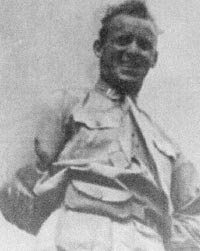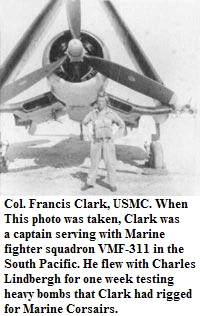|
|||||||
|
The base commander gave Clark permission to build and test such a bomb rack. This version of the Corsair had not been designed to carry a bomb that heavy. Clark proceeded to build and test the rack. Lindbergh who was working as a consultant for the producer of the Corsair learned of Clark’s program and visited the island. For the next two weeks Lindbergh and Clark worked together to modify the Corsair to carry a 2000-pound bomb on the centerline with a 1000 pound bomb under each wing. Lindbergh would fly the Corsair loaded with bombs while Clark flew a corsair equipped with a camera. Clark took photos of each target before and after Lindbergh bombed it. These were real bombing missions against Japanese targets protected with anti aircraft gun emplacements. Clark reported that all of the 2000-pound bombs that had been placed in the bunker were carried to military targets by the Corsairs. The following article with details of the above synopsis was prepared by Staff Writer Scott Price and published in the Colleyville Texas Courier on May 14, 2004. This story is presented as published with the permission of Charles D. Young, Publisher and Editor of “The Courier”.
Local WWII Fighter Pilot Flew with Lindbergh By Scott Price Colleyville resident Col. Francis "Fran" Clark, 83, was inspired to become a pilot as a child, when Charles A. Lindbergh made his historic solo flight across the Atlantic Ocean. Clark never dreamed he would one day get the chance to fly as Lindbergh's wingman. On May 21, 1927, Lindbergh took off in The Spirit of St. Louis from Roosevelt Field in New York, and 33 and one half hours later, landed in Paris to accolades of thousands of cheering people. The man who was given the nicknames of "The Lone Eagle" and "Lucky Lindy" was the first person to successfully fly non-stop across the Atlantic Ocean. "When I was 6 years old, Charles Lindbergh flew that plane all the way across the Atlantic, and he was my idol," Clark said. "It was then that I decided to be a pilot." Clark was 16 years old, and living in Michigan, when he got his big chance. The United States government had a program in Pontiac, Mich. that offered free flight lessons, which Clark said they did in the years immediately prior to World War II. Clark was one of the people who took lessons in the standard program trainer, the Piper Cub. He was a licensed pilot at the ripe old age of 17. Also at that time, Clark was studying engineering in college and working for Ford Motor Company. In September 1941, shortly before Pearl Harbor was bombed by the Japanese, Clark joined the U.S. Navy as an officer cadet. He finished in the top two percent in training and was given a number of options as a pilot. Clark elected to join the Marine Corps, which made it possible for him to fly the new F4U Corsair as a fighter pilot. "I had gone from 65 horsepower in the Piper, to 1,000 horsepower in one of the trainers, to a Corsair with 2,000 horsepower," he said. Clark said the Corsair was designed for speed and efficiency and could be an unforgiving airplane, especially for an inexperienced pilot. Not long after he checked out in the Corsair, Clark was making a turn as he made an approach for landing when he discovered that the plane did not turn as sharply at slow speeds as the trainer he had been flying. He gave the Corsair full throttle, intending to pull up and go around, but the 2,000 horsepower engine produced so much torque that it twisted the plane to the left and, at that slow speed, Clark could not straighten the plane out in what little altitude he had left. "I came in and made a three-point landing - on the left landing gear, the left wing Clark said a warning was sent out after that to "not to give the Corsair full throttle at slow speeds when making a left tum," because of the high torque. Clark soon gained enough experience in the F4U that he became comfortable with the high performance fighter. The Corsair, Clark said, could fly up to '440 mph and had a ceiling of more than 40,000 feet. Clark was assigned to Marine fighter squadron VMZF-3 11. Clark said that he and 11 other pilots were sent to California, loaded on a small aircraft carrier and transported to the South Pacific. Clark said no one told them where they were going. They were taken to a small island that had a runway not far inland, so the aviators got a crash course in being carrier pilots. Clark said his squadron made bombing and strafing runs on Japanese positions, but they didn't see many Japanese planes.
An atoll is sand that has built up on a coral, reef. Kwajalein Atoll had a runway built on it. Clark and his fellow pilots had the job of patrolling the area and keeping it clear of any Japanese planes. Clark said they saw very few Japanese planes. But Clark said he and his squadron did fly many missions attacking Japanese-held islands. The military had planned to use Kwajalein Atoll as a launching point for bombers, but engineers determined that they could not extend the runway sufficiently. Meanwhile, bunkers on the atoll had been filled with 2,000-pound bombs in anticipation of the bombers' arrival. Clark, who was a captain by then, said he got the idea of building a bomb rack on the Corsair's fuselage, under the wings. The base commander gave Clark permission to build and test his bomb rack. His orders were to report to the base commander every evening and to "take small steps" before putting a 2,000-pound bomb on the Corsair, which had not been designed to carry a bomb that large. Clark said on Sept. 1, 1944, the base commander ordered him to report to his office. He was informed that Lindbergh had arrived at the base. Clark was stunned when he was told that Lindbergh had come to the base because he was interested in Clark's experiments with the Corsair. Clark's idol was working 'at the time as a liaison to the Marine Corps for United Aircraft Corporation, producer of the F4U Corsair. Lindbergh was not a military officer at this time. He had resigned his commission as a colonel in the Army Air Corps Reserves in 1941 after President Franklin D. Roosevelt had called Lindbergh's patriotism into question. Lindbergh had recommended earlier that the U.S. remain neutral in World War II. After the Japanese attacked Pearl Harbor on Dec. 7, 1941, Lindbergh asked to be allowed back into the military, but Roosevelt did not allow it. For two weeks, Clark and Lindbergh worked together on modifying the Corsair to carry more bombs. They slowly worked their way up to putting a 2,000-pound bomb in the center of the Corsair and a 1,000-pound bomb on either side of it. The first time Lindbergh got into a Corsair, Clark was worried that Lindbergh might not know how to handle the plane. He said he found out much later that Lindbergh had been flying Corsairs with the Marine Corps all over the South Pacific. According to Clark, Lindbergh was in the South Pacific flying military missions with the United States military without the knowledge of either the Secretary of the Navy or the White House. Lindbergh would fly the Corsair loaded with bombs, Clark said, while Clark flew a Corsair equipped with a camera. Clark took photos of each target before and after Lindbergh bombed it. Clark said in order to bomb a target, a pilot had to roll the Corsair to one side to see the target, then do an inverted dive until the bombs were released, then pull up. These were real military missions, and the pair was bombing Japanese positions. "They were not friendly," Clark said. "They shot a lot of bullets." Clark said he does not know the total number of bomb runs he and Lindbergh made together, but they made numerous runs over a two-week period. Clark said he did notice one interesting thing about the way Lindbergh flew. On one occasion, Clark was rolling down the runway just behind Lindbergh's right wing and had to back off because Lindbergh was drifting to the right. "He never looked to the side," Clark said. Clark said he enjoyed his time with Lindbergh, a man he describes as soft-spoken and direct. "He was my idol, and he was just every bit as good or better than I thought he was," Clark said. "He knew how to fly. He was good. He just didn't know how to fly with anyone else." Maybe they didn't call Lindbergh "The Lone Eagle" for nothing. Lindbergh left on Sept. 14, 1944, and went on to fly other Corsairs and the P-38 Lighting, a twin-engine fighter-bomber, in combat. In August 1945, Clark was at El Toro, Calif., Marine Base when he gave a lift to two men and two women. One of those women was Pat Clark, who would become his wife of 58 years. "She wouldn't get out of the car, so I married her," Fran said with a smile. The Clark's have three children: Karna Doyle, 56, a psychology professor at the University of Michigan; David Clark, 55, a parole supervisor in Fort Worth; and Francene McPherson, 54, a retired psychologist traveling the country by motor home with her husband. Clark went back to work for Ford Motor Company after World War II, but was called up again for the Korean War, where he served 13 months flying the Sky Raider, a dive-bomber. Pat Clark said she got into timed car racing in the 1950s. She then went on to get her pilot's license and got involved in cross-country plane racing. The Clarks moved to Colleyville in 1980 to be close to their flying friends they got to know through the All Texas Air Tour, an annual airplane rally to promote aviation in Texas. The air tour began in 1947 and ended in 1982. The Clarks owned their own airplanes for many years but gave up flying in 1989. "I thought I would miss it terribly, but I didn't miss it all because we got in that motor home and traveled all over the United States and all the way to Alaska," Fran said. From looking around Clark's home, it is clear that he still holds a lot of affection for the F4U Corsair that he flew in World War II. You can read more about Clark's experiences with Lindbergh in The Wartime Journals of Charles A. Lindbergh. More F4U: Operation Summary WWII
|
|||

 In WWII the bunkers on Kwajalein Atoll had been filled with 2000-pound bombs with the mistaken idea that the existing runway could be lengthened to accommodate bombers. Francis Clark, a Captain at that time, was a Marine Fighter Pilot flying an F4U-1 Corsair. On bombing missions attacking the Japanese held islands. Clark got the idea of building a bomb rack under the wing at the airplane centerline to carry the 2000-pound bombs.
In WWII the bunkers on Kwajalein Atoll had been filled with 2000-pound bombs with the mistaken idea that the existing runway could be lengthened to accommodate bombers. Francis Clark, a Captain at that time, was a Marine Fighter Pilot flying an F4U-1 Corsair. On bombing missions attacking the Japanese held islands. Clark got the idea of building a bomb rack under the wing at the airplane centerline to carry the 2000-pound bombs.
 Later in the war, Clark and his squadron were sent to Kwajalein Atoll in the Marshall Islands.
Later in the war, Clark and his squadron were sent to Kwajalein Atoll in the Marshall Islands.